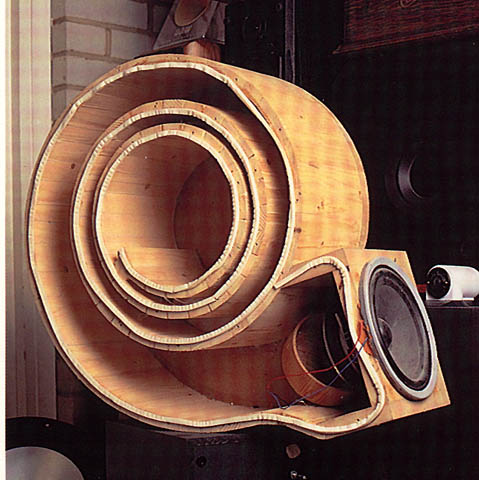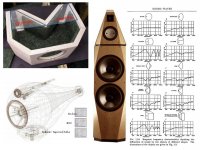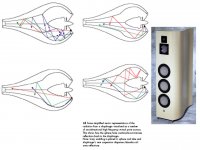Hello there all you box experts.
I'm planning to test build a sealed midwoofer @ ~ 80-500 hz and I'm wondering about the box.
What is the best enclosure design for completely suppressing the back wave and thus approximate an infinite baffle? I will go active with DSP so Q, low end response and easily fixable resonances can be ignored.
So far I've found 3 potential candidates:
1. Normal vanilla box, square or rectangular.
2. Pipe box, like the linkwitz Pluto.
3. Reverse horn box, like the B&W Nautilus.
I don't want the box to be astronomically large so I'm seeking the most space efficient alternative that does the job, preferably around 30x60x60 cm or less.
But which ( if any ) of those alternatives is the best, and if none of these then tell me!
// The Olle with the insatiable hunger for knowledge
I'm planning to test build a sealed midwoofer @ ~ 80-500 hz and I'm wondering about the box.
What is the best enclosure design for completely suppressing the back wave and thus approximate an infinite baffle? I will go active with DSP so Q, low end response and easily fixable resonances can be ignored.
So far I've found 3 potential candidates:
1. Normal vanilla box, square or rectangular.
2. Pipe box, like the linkwitz Pluto.
3. Reverse horn box, like the B&W Nautilus.
I don't want the box to be astronomically large so I'm seeking the most space efficient alternative that does the job, preferably around 30x60x60 cm or less.
But which ( if any ) of those alternatives is the best, and if none of these then tell me!
// The Olle with the insatiable hunger for knowledge
You have competing interests.
With a fixed box volume, your internal treatment has to not take up too much volume, but still has to absorb the energy - which means turn it into heat, btw. Once the treatment that does the absorbing gets too dense, it stops looking like the same box volume and the box gets smaller quickly... which is tough to overcome by electronic means. Speakers seem to want to do things acoustically no matter what you do to control them electronically. Said another way, the less (within reason) electronic control (EQ) is applied the more effective it is... as with a high Q mechanical resonance in a cone, you can stop exciting it with electrical energy, but it will not entirely go away.
Anyhow, you didn't say what size driver...
there are tradeoffs in the box no matter what.
Like panel area - makes a difference wrt flatness of response and things like baffle step.
Potentially the long narrow enclosures with fill - like a pipe or "reverse horn" (it's merely a TL) have the potential benefit of a greater delay time for the reflected wave - it's a benefit depending on how long and what freq that works out to be. IF it was below the lowest freq of interest, then possibly a big benefit!
What you use inside any enclosure counts big time.
_-_-bear
With a fixed box volume, your internal treatment has to not take up too much volume, but still has to absorb the energy - which means turn it into heat, btw. Once the treatment that does the absorbing gets too dense, it stops looking like the same box volume and the box gets smaller quickly... which is tough to overcome by electronic means. Speakers seem to want to do things acoustically no matter what you do to control them electronically. Said another way, the less (within reason) electronic control (EQ) is applied the more effective it is... as with a high Q mechanical resonance in a cone, you can stop exciting it with electrical energy, but it will not entirely go away.
Anyhow, you didn't say what size driver...
there are tradeoffs in the box no matter what.
Like panel area - makes a difference wrt flatness of response and things like baffle step.
Potentially the long narrow enclosures with fill - like a pipe or "reverse horn" (it's merely a TL) have the potential benefit of a greater delay time for the reflected wave - it's a benefit depending on how long and what freq that works out to be. IF it was below the lowest freq of interest, then possibly a big benefit!
What you use inside any enclosure counts big time.
_-_-bear
The driver is a 10 inch, and ofc if the box has to be bigger then that's fine of course but if one alternative can produce a smaller box then it is of course interesting =)
If I've understood correctly the ideal box is basically a tube that is infinitely long? And that said tube can be narrowed down into an inverse horn to save space.
Is it better to leave a round area in the middle like in the picture or would it be better to continue the horn and make it longer?
And another question about damping, am I supposed to damp equally much everywhere in the box or more / less in some places?
The current idea is to use a factory-sealed dome midrange like the TB75 or the ATC SM75 so I won't have to bother about a box there.
Thanks,
Olle
If I've understood correctly the ideal box is basically a tube that is infinitely long? And that said tube can be narrowed down into an inverse horn to save space.
Is it better to leave a round area in the middle like in the picture or would it be better to continue the horn and make it longer?
And another question about damping, am I supposed to damp equally much everywhere in the box or more / less in some places?
The current idea is to use a factory-sealed dome midrange like the TB75 or the ATC SM75 so I won't have to bother about a box there.
Thanks,
Olle
You will probably get a lot of nonsense answers based on your question.
All of the enclosure shapes suggested would be strongly resonant in a variety of ways if they are not filled with appropriate stuffing. However, once you start to fill them then the influence of their shape disappears. The key is sufficient depth of good stuffing. Filling the depth (and width and height) of the cabinet with 1/4 it dimension in fiberglass will absorb 99% of the energy. This gets the stuffing material from the cabinet surface (where it is less effective) to the velocity maximum point away from the surfaces. You can lightly stuff the whole box or even leave an air gap behind the stuffing.
Once appropriately stuffed, the cabinet shape become irrelevant. The only way any long skinny cabinets (of nearly any shape) would be required is if the absorbing material is very poor. One danger of any TL shaped boxes is that they tend to have the other two dimensions reduced (for the same volume) and sideways modes can crop up.
David S.
All of the enclosure shapes suggested would be strongly resonant in a variety of ways if they are not filled with appropriate stuffing. However, once you start to fill them then the influence of their shape disappears. The key is sufficient depth of good stuffing. Filling the depth (and width and height) of the cabinet with 1/4 it dimension in fiberglass will absorb 99% of the energy. This gets the stuffing material from the cabinet surface (where it is less effective) to the velocity maximum point away from the surfaces. You can lightly stuff the whole box or even leave an air gap behind the stuffing.
Once appropriately stuffed, the cabinet shape become irrelevant. The only way any long skinny cabinets (of nearly any shape) would be required is if the absorbing material is very poor. One danger of any TL shaped boxes is that they tend to have the other two dimensions reduced (for the same volume) and sideways modes can crop up.
David S.
1/4 or 1/2 of what? 1/4 or 1/2 wavelength of what frequency?
David S.
I'd guess at lower crossover frequency, or a bit lower.
The tapered pipe needs to be long enuff that the lowest frequency of interest passes thru a w/l of damping material on its trip to the end and back. The tapered shape can be shorter than a straight pipe (see King).
Volume should be that of a suitable sealed box.
The picture is of a prototype Nautilus.
dave
Volume should be that of a suitable sealed box.
The picture is of a prototype Nautilus.
dave
A long length of large PVC pipe that takes the back wave outside the house. Sort of a "true" infinite baffle.
Nope. A long constant diameter PVC tube without any stuffing will have a tremendously bad pipe mode resonance at half a wavelength and multiples. Making it longer just lowers the frequency of the fundamental resonance but doesn't eliminate anything.
By the time you have added enough stuffing to damp the pipe mode resonance you might as well have just used a well stuffed closed box...
By the time you have added enough stuffing to damp the pipe mode resonance you might as well have just used a well stuffed closed box...
What, no magic box shape for minimum reflections? That's pretty boring.
David S.
Watch out for slugs.A long length of large PVC pipe that takes the back wave outside the house. Sort of a "true" infinite baffle.
The difference between a well-stuffed long pipe and a well-stuffed closed box is that you are going to get less reflected sound passing through the diaphragms of the drivers. Probably.Nope. A long constant diameter PVC tube without any stuffing will have a tremendously bad pipe mode resonance at half a wavelength and multiples. Making it longer just lowers the frequency of the fundamental resonance but doesn't eliminate anything.
By the time you have added enough stuffing to damp the pipe mode resonance you might as well have just used a well stuffed closed box...
The driver is a 10 inch...
If I've understood correctly the ideal box is basically a tube that is infinitely long? And that said tube can be narrowed down into an inverse horn to save space.
Olle
DIFFRACTION anyone?
There are a couple free box diffraction simulators, as well as free room effect simulators that are worth the effort to learn. Large edge round-overs and irregular shaped edges are necessary to reduce diffraction.
As discussed, absorbing the rear cone wave can be handled several ways and requires engineering on both the shape and absorption material. I like to use slightly wider than minimum front baffles in order to give the inside rear cone wave enough air to avoid direct reflection. You have seen how thick baffle boards are routed out to allow the rear side cone air a good escape path.
Attachments
The difference between a well-stuffed long pipe and a well-stuffed closed box is that you are going to get less reflected sound passing through the diaphragms of the drivers. Probably.
Less with which?
The odd thing is that there is no distinction between the two unless you create some artficial boundary based on length to width ratio.
Lets do that. Compare a cubical enclosure to the same volume but with depth 5 times the width and height. For both cases there will be modes in all 3 dimensions. The longer unit will be called by some as a half wave TL but it isn't a TL at all. It will have resonances at a frequency where its depth is a 1/2 wavelength, 3/2 wavelength, etc., but so will the cubic enclosure, right? Every cabinet of any aspect ratio will have the same series of resonances at frequencies proportional to each dimension.
But won't we have the benefit of more length to apply damping? Yes, but we will need it. With 5 times the length all the resonances will be at 1/5th the frequency. Since absorber cuttoff is proportional to material depth (twice the material to effectively absorb twice the wavelength) we will always need the same percentage of treatment.
If you study the absorption curves of fiberglass you will see it works pretty well for frequencies above a depth of 1/6th wave (near total absorption above the 1/4 wave equivalent). So line any enclosure for 1/4 its depth (and sides, top and bottom) and you will pretty well eradicate the back wave.
I know the pseudo TL cool aid has been drunk by many but we really should examine the physics of it.
David S
Compare a cubical enclosure to the same volume but with depth 5 times the width and height. For both cases there will be modes in all 3 dimensions. The longer unit will be called by some as a half wave TL but it isn't a TL at all. It will have resonances at a frequency where its depth is a 1/2 wavelength, 3/2 wavelength, etc., but so will the cubic enclosure, right? Every cabinet of any aspect ratio will have the same series of resonances at frequencies proportional to each dimension.
But won't we have the benefit of more length to apply damping? Yes, but we will need it. With 5 times the length all the resonances will be at 1/5th the frequency. Since absorber cuttoff is proportional to material depth (twice the material to effectively absorb twice the wavelength)
So the conclusion we can make from this elegant analysis is that the pipe absorbs the back wave to 1/5th the frequency of the cube. And since the question under scrutiny is how to attempt to absorb all of ths back wave, then we can look at the pipe as having considerably larger bandwidth.
dave
So Dave are you saying that odd angles and shapes have "NO" influence if you use appropriate stuffing??
This makes box building much easier, so with Vb = Vas and smaller is 25% stuffing still enough?
I think the ideal midbass cabinet is shaped like a sphere to allow the cone rear wave DYNAMICS to EXPLODE without interference and then get quickly absorbed without any resonance by a stuffed, tapered rear cavity with a tiny open exit. With a sphere, diffraction is almost ideal but a difficult shape to construct and integrate into a multi-way speaker.
B&W 801 genius engineers did their homework. Avalon genius engineers, Focal Grande Uotopia, WhiteLight engineers worry about rear waves and diffraction using more standard construction.
Attachments
- Status
- This old topic is closed. If you want to reopen this topic, contact a moderator using the "Report Post" button.
- Home
- Loudspeakers
- Multi-Way
- Best sealed enclosure for completely supressing back wave


